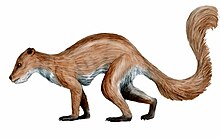Plesiadapiformes
| Plesiadapiformes | |
|---|---|

| |
| Plesiadapis | |
| Scientific classification | |
| Domain: | Eukaryota |
| Kingdom: | Animalia |
| Phylum: | Chordata |
| Class: | Mammalia |
| Clade: | Pan-Primates |
| Order: | Plesiadapiformes Simons and Tattersall, 1972 |
| Families | |
Cladistically included but traditionally excluded
| |
| Synonyms | |
| |
Plesiadapiformes ("Adapid-like" or "near Adapiformes") is an order of Primatomorpha.[1][2][3][4] While none of the groups normally directly assigned to this group survived, the group appears actually not to be literally extinct (in the sense of having no living descendants) as the remaining primates (the crown primates or "Euprimates") appear to be derived Plesiadapiformes, as sister of e.g. the Carpolestidae. The term Plesiadapiformes may still be used for all primates which are not crown primates, but this usage is obviously paraphyletic. When the crown primates are cladistically granted, it becomes an obsolete junior synonym to primates. Purgatorius is believed to be a basal Plesiadapiformes.
Plesiadapiformes first appear in the fossil record between 65 and 55 million years ago,[5] although many were extinct by the beginning of the Eocene. They may have been the first mammals to have finger nails in place of claws.[6] In 1990, K.C. Beard attempted to link the Plesiadapiformes with the order Dermoptera. They proposed that paromomyid Phenacolemur had digital proportions of the fossil indicated gliding habits similar to that of colugos.[7]
In the following simplified cladogram, the crown primates are found highly derived Plesiadapiformes, possibly as sister of the Carpolestidae.[4][clarification needed] The crown primates are cladistically granted here into the Plesiadapiformes, and the 'plesiadapiformes' become a junior synonym of the primates. With this tree, the plesiadapiformes are not literally extinct (in the sense of having no surviving descendants). The crown primates are also called "Euprimates" in this context.
| Euarchontoglires |
| ||||||||||||||||||||||||
In 2018, the plesiadapiform were proposed to be more related to Dermoptera, or roughly corresponding to Primatomorpha with both Dermoptera and the primates emerging within this group.[8][9]
One possible classification table of plesiadapiform families is listed below.
- ORDER PLESIADAPIFORMES
- Family Micromomyidae
- Superfamily Paromomyoidea
- Family Paromomyidae
- Family Picromomyidae
- Family Palaechthonidae
- Family Picrodontidae
- Family Microsyopidae
- Superfamily Plesiadapoidea
- Family Chronolestidae
- Family Plesiadapidae
- Superfamily Carpolestoidea
- Family Carpolestidae
References
- ^ Henke, Winfried; Tattersall, Ian; Hardt, Thorolf (2007). Handbook of Paleoanthropology: Vol I:Principles, Methods and Approaches Vol II:Primate Evolution and Human Origins Vol III:Phylogeny of Hominids. Springer Science & Business Media. p. 839. ISBN 978-3-540-32474-4. Retrieved 25 January 2015.
- ^ Boyer, Doug M.; Costeur, Loïc; Lipman, Yaron (2012). "Earliest record of Platychoerops(Primates, Plesiadapidae), a new species from Mouras Quarry, Mont de Berru, France". American Journal of Physical Anthropology. 149 (3): 329–346. doi:10.1002/ajpa.22119. ISSN 0002-9483. PMID 22926965.
- ^ Ni, X.; Meng, J.; Beard, K. C.; Gebo, D. L.; Wang, Y.; Li, C. (2009). "A new tarkadectine primate from the Eocene of Inner Mongolia, China: phylogenetic and biogeographic implications". Proceedings of the Royal Society B: Biological Sciences. 277 (1679): 247–256. doi:10.1098/rspb.2009.0173. ISSN 0962-8452. PMC 2842661. PMID 19386655.
- ^ a b Silcox, Mary T.; Bloch, Jonathan I.; Boyer, Doug M.; Chester, Stephen G. B.; López‐Torres, Sergi (2017). "The evolutionary radiation of plesiadapiforms". Evolutionary Anthropology: Issues, News, and Reviews. 26 (2): 74–94. doi:10.1002/evan.21526. ISSN 1520-6505. PMID 28429568.
- ^ Paleontologists discover most primitive primate skeleton - PhysOrg.com
- ^ ""Sleep, First Primates, Earthquakes in the Midwest and Profile: Sang-Mook Lee"". NOVA scienceNOW. Season 4. Episode 8. 9 July 2008. 13:04 minutes in. PBS. Transcripts – NOVA scienceNOW: 9 July 2008.
{{cite episode}}: External link in|transcripturl=|serieslink=ignored (|series-link=suggested) (help); Unknown parameter|transcripturl=ignored (|transcript-url=suggested) (help) - ^ K.C. BeardGliding behaviour and palaeoecology of the alleged primate family Paromomyidae (Mammalia, Dermoptera) Nature, 345 (1990), pp. 340-341
- ^ Morse, Paul E.; Chester, Stephen G.B.; Boyer, Doug M.; Smith, Thierry; Smith, Richard; Gigase, Paul; Bloch, Jonathan I. (2019). "New fossils, systematics, and biogeography of the oldest known crown primate Teilhardina from the earliest Eocene of Asia, Europe, and North America". Journal of Human Evolution. 128: 103–131. doi:10.1016/j.jhevol.2018.08.005. PMID 30497682.
- ^ Godinot, Marc (16 April 2017), "Paleocene and Eocene Primates", in Bezanson, Michele; MacKinnon, Katherine C; Riley, Erin; Campbell, Christina J (eds.), The International Encyclopedia of Primatology, John Wiley & Sons, Inc., pp. 1–9, doi:10.1002/9781119179313.wbprim0331, ISBN 9781119179313
